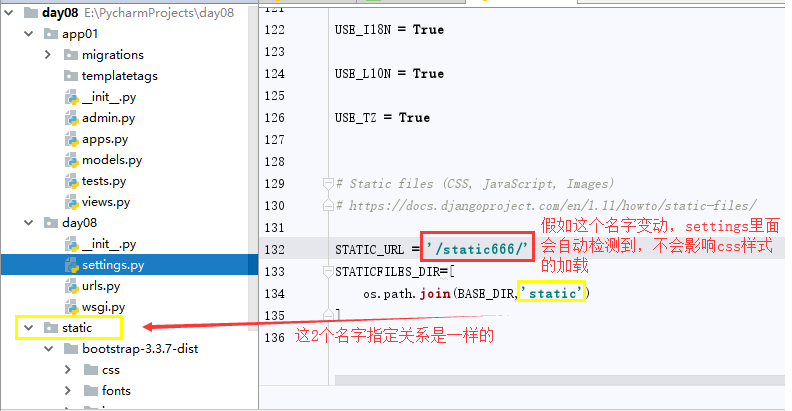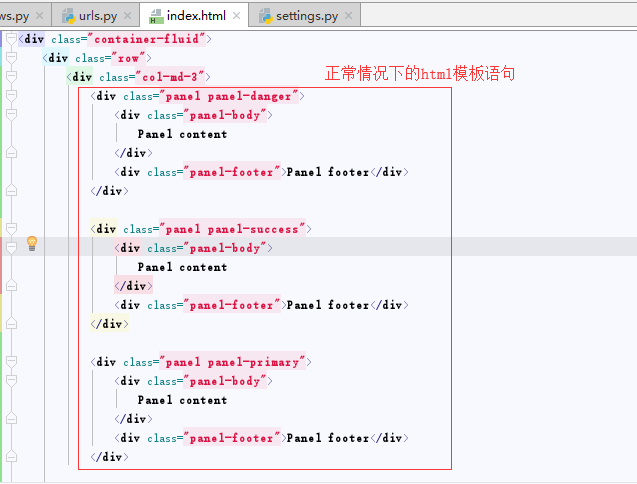Django模板导入和替换、以及对数据库的增加、查看
静态文件引入的3中方式:例如对html模板里面对css样式的引入
STATIC_URL = '/static666/'
STATICFILES_DIR=[
os.path.join(BASE_DIR,'static')
]
目的是在settings里面名字变动时,模板里面能时时进行检测和变动,从而不影响页面css样式的加载
<head> <meta charset="UTF-8"> <title>模板的导入和继承</title> <!--方式一:--> {# <link rel="stylesheet" href="/static/bootstrap-3.3.7-dist/css/bootstrap.min.css">#} <!--方式二:就是settings里面STATIC_URL = '/static666/'后面的值无论如何变动都不会有影响,对应css样式的加载,都能识别到STATIC_URL地址的变动--> {% load static %} <link rel="stylesheet" href="{% static 'bootstrap-3.3.7-dist/css/bootstrap.min.css'%}"> {# 返回值:/atic/bootstrap-3.3.7-dist/css/bootstrap.min.css#} <!--方式三:--> <link rel="stylesheet" href="{% get_static_prefix %}/bootstrap-3.3.7-dist/css/bootstrap.min.css"> {# 返回值:/static#} <style> </style> </head>
图解说明:


模板的导入:
模板导入:
1 把公共部分,放到html里,比如叫 left.html
2 想在哪里用 {% include 'left.html' %}
正常情况下模板里面直接写html语句

要实现的就是,将html中一段代码单独放在一个html文件中,其他地方使用的时候去导入就OK:

<div class="panel panel-danger"> <div class="panel-body"> Panel content </div> <div class="panel-footer">Panel footer</div> </div> <div class="panel panel-success"> <div class="panel-body"> Panel content </div> <div class="panel-footer">Panel footer</div> </div> <div class="panel panel-primary"> <div class="panel-body"> Panel content </div> <div class="panel-footer">Panel footer</div> </div>
<div class="container-fluid"> <div class="row"> <div class="col-md-3"> #页面里面直接去调用(在哪个位置调用,就在哪个位置显示) {% include 'left.html' %} </div> </div>
模板的继承:
页面切换,母版是固定不动的,所以一些固定不变的可以让他继承不变,相当与空白的盒子,让后面要用的继承这个盒子,再写内容
继承不步骤:
母版继承:
1 写一个母版 base.html
2 要更改的地方( )
{% block base %}
母版的盒子里也可以写东西
{% endblock %}
3 调用:
3.1 写在第一行 {%extends 'base.html' %}
3.2 {% block base %}
自己的东西
{% endblock my_head%}
3.3 还想用母版里的内容({{block.super}} 放在那,原来母版里的东西,就会渲染在哪)
{% block base %}
{{block.super}}
自己的东西
{% endblock my_head%}
3.4 如过不继承盒子,它会用原来的内容,如果继承了,没写自己的东西,它会空白
3.5 盒子再继承时,跟顺序无关
例如下面:
首先,定义一个母模板base.html
<!DOCTYPE html> <html lang="en"> <head> <meta charset="UTF-8"> <title>母模板样式</title> <link rel="stylesheet" href="/static/bootstrap-3.3.7-dist/css/bootstrap.css"> <style> .head { height: 100px; width: 100%; background-color: deepskyblue; } </style> </head> <body> <div class="head"></div> <div class="container-fluid"> <div class="row"> <div class="col-md-3"> {% block base_left %} 母模板原col-md-3左侧内容 {% endblock %} </div> <div class="col-md-9"> {% block base_right %} 母模板原col-md-9右侧内容 {% endblock base_right %} </div> </div> </div> </body> </html>
其次,定义一个子模板order.html,并配置
<!--先导入父模板--> {% extends 'base.html' %} <!--指定重写继父模板固定那哪一块儿内容,重新写自己的新内容--> {% block base_left %} <!--默认会覆盖掉父模板对应位置的内容,如果要保留原有内容可以写block.super--> {{ block.super }} <hr> <!--本页面新增内容--> 继承过来的左侧新页面,自己的新内容 {% endblock %} <!--结束时候另外一种写法,endblock后面可以指定结束的的盒子名称(也可以不写)--> {% block base_right %} {{ block.super }} <hr> 继承过来的右侧新页面,自己的新内容 {% endblock base_right%}
最后,实现子模板继承母模板的样式,并且在继承的基础上可以重写自己页面的新内容

数据库的增加:
models.py里面的先配置数据库表的字段及类型
from django.db import models # Create your models here. from django.db import models class Book(models.Model): nid=models.AutoField(primary_key=True) name=models.CharField(max_length=40) price=models.DecimalField(max_digits=5,decimal_places=2) pub_date=models.DateField() author=models.CharField(max_length=40) publish=models.CharField(max_length=60)
views.py函数里面对数据的增加操作:
from django.shortcuts import render # Create your views here. from app01.models import * def index(request): #数据库增加 #方法1:(推荐使用第一种方式) Book.objects.create(name='书4',price=56,pub_date='1992-10-12',author='作者1',publish='人民出版社') import datetime #传字符串必须是:2014-09-18,也可以传datetime类型 now = datetime.datetime.now() Book.objects.create(name='书9',price=25.4,pub_date=now,author='作者9',publish='中央出版社99') book=Book.objects.all().values('name','price') #<QuerySet [{'name': '书1', 'price': Decimal('23.40')}, {'name': '书1', 'price': Decimal('23.40')}, print(book) #方法2:(最后记得要保存) book=Book(name='书3',price=30,pub_date='2001-01-12',author='作者3',publish='上海出版社') print(book,type(book)) book.save() return render(request,'index.html')
数据库的查询:
views.py对数据库的查询操作:
# Create your views here. from app01.models import * def index(request): #数据查看 #方法1:filter filter(queryset对象)相当于sql的where后面传的参数,是and的关系 books=Book.objects.filter(publish='中央出版社',) print(books) #<QuerySet [<Book: Book object>, <Book: Book object>, <Book: Book object>]> 查看的是所有满足条件的列表 print(books.first()) #Book object 取出列表中第一个,就对行啊 print(books[0]) #Book object同上面一样 print(books.first().nid) # 1 print(books[0].nid) #同上面一样 #方法2:get后面条件参数,必须是数据库里面是唯一的一个,不然会报错 book = Book.objects.get(name='书1') #例如:这种就会报错 book=Book.objects.get(nid=4) print(type(book)) #<class 'app01.models.Book'> print(book.name) #方法3: #拿所有的 - -queryset对象 book=Book.objects.all() # first() 从queryset里取出第一个值---->book对象 book=Book.objects.all().first() print(book) #Book object print(book.nid) #1 print(book)# #[<Book: Book object>, <Book: Book object>,.. book = Book.objects.all().values('name','price') print(book) #<QuerySet [{'name': '书1', 'price': Decimal('23.40')}, .. # 一旦返回是queryset对象,可以继续点它的方法 book = Book.objects.all().values('name', 'price').filter(name='书1') print(book) #exclude查找排除谁之外的所有结果 book=Book.objects.all().exclude(author='作者1') print(book.first().nid) #3 #order_by默认是从小到大,想要从打到小- book = Book.objects.all().order_by('price') book=Book.objects.all().order_by('-price') print(book.first().name) # count 计算有多少条数据信息 book=Book.objects.all().count() print(book) #29 book=Book.objects.all().last() print(book.name) #exists判断queryset里有没有数据,没有就false,有就是true res=Book.objects.all().exists() print(res) #true #values_list:是元祖的形式 book=Book.objects.all().values_list('name','price') #结果[(),()]里面是元祖 print(book.order_by('price')) #distinct去重 #去重前查询结果 book=Book.objects.values('publish') #<QuerySet [{'publish': '中央出版社'}, {'publish': '中央出版社'}, {'publish': '上海出版社'}, #去重后查询结果 book=Book.objects.values('publish').distinct() #<QuerySet [{'publish': '中央出版社'}, {'publish': '上海出版社'}, {'publish': '人民出版社'}, print(book) #reverse反转要放到order_by后面 book=Book.objects.all().order_by('-price','pub_date').values_list().reverse() print(book) return render(request,'index.html')




